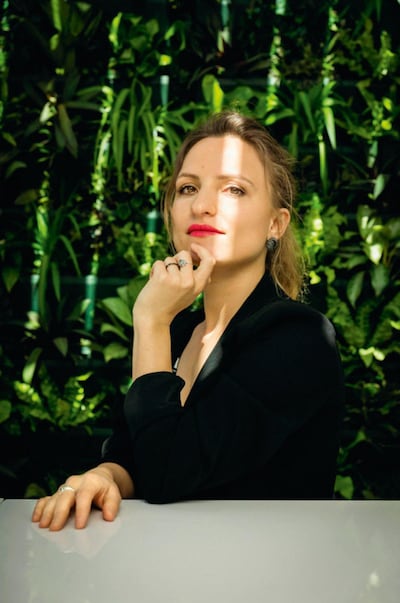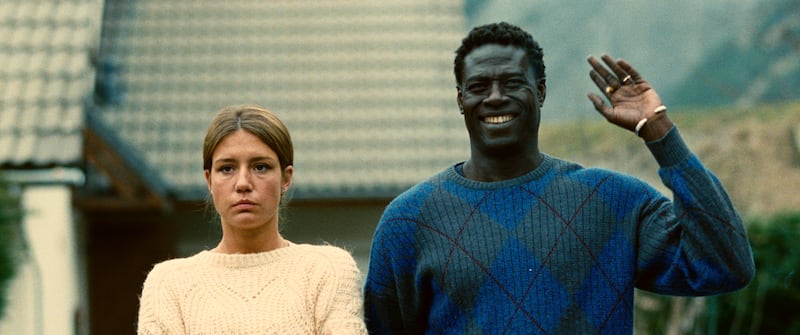It’s tricky to re-create smells on film. Just ask John Waters, who had Odorama scratch-and-sniff cards distributed at screenings of his film Polyester, in 1981, so audiences could experience the scent of dirty feet and skunk in sync with the movie’s housewife heroine, Francine Fishpaw.
Léa Mysius’s second feature, The Five Devils, gets impressively close to conveying the emotional and autobiographical aspects of fragrance.
“It was difficult to conceptualise how to film something that’s invisible like scent,” says the film-maker. “I do, in fact, like working with the senses and something that’s very bodily, very physical. And then that kind of opens up a world of smells and how smells then activate memories. When you smell something from childhood, you have images that start to encroach in. But what if there’s something a bit more fantastical to it, something more than your subconscious at work?”
The Five Devils’ preteen heroine, Vicky (played by the impressive newcomer Sally Dramé), possesses a sense of smell that allows her to snuffle her mother in the middle of a forest while blindfolded. The youngster also concocts potions that correspond to her nearest and dearest. So when her estranged aunt Julia arrives with new and potent odours, Vicky is transported back in time to witness the crazed melodrama that came between her swimming-instructor mother (played by Adèle Exarchopoulos), her firefighter father (Moustapha Mbengue) and the troubled aunt (Swala Emati).
New homes: comprehensive guide to what’s for sale in Dublin, Wicklow, Kildare, Meath, Cork and around the State
‘They’re supposed to represent us, not sue us’: Crafts council threatens members after critical feedback
If Robert De Niro no longer feels he is able to speak out, one wonders who in the US does
The White Lotus review: Season three has its finger on the pulse to an almost excruciating degree
Strap in for aquatic exercises, a horrible fire, an LGBTQ romance and a full-blooded karaoke rendition of Bonnie Tyler’s Total Eclipse of the Heart.
“The very first image that popped into my head was of a young woman in front of a fire, screaming,” says Mysius, who wrote the screenplay with her partner and cinematographer, Paul Guilhaume. “I just had this image in my head. But then I also wanted to tell this story of a young girl which was quite burlesque and odd: a young girl with a specific gift for scent and smell. I wanted to merge these two stories, and that’s what created the foundations of the script.”

When the genre-bending Five Devils premiered at the Directors’ Fortnight section of Cannes last year, critics were quick to compare it to the similarly ambitious Titane, Julia Ducournau’s Palme d’Or winner. If Ducornau’s work sits adjacent to vampires (Raw) and, in Titane, the fast and furious, Mysius’s new film is a very French rendition of a superhero movie, replete with sex and Alpine tableaux.
“Initially I did use some of the codes of the genre, the superhero genre – so, in the way that she discovers her gifts and the pleasure she experiences as she uses those gifts for the first time – but then I didn’t want to stick with that formula,” says the writer-director. “I wanted to lean towards something else. So the superhero story acts as a gateway to tell the story of the girl who’s discovering her origins. Her origins are more important than the superpower.”
Sense is hugely important in Mysius’s work. Her feature-film directorial debut, Ava, which premiered in Cannes in 2017, followed a 13-year-old girl (Noée Abita) who spends a summer by the sea shortly before she completely loses her sight due to retinitis pigmentosa. The film, Mysius’s graduation project from La Fémis, won the Sutherland award for first feature at the BFI London Film Festival.
That year she also co-wrote Ismael’s Ghosts, Arnaud Desplechin’s film starring Mathieu Amalric, Marion Cotillard, Charlotte Gainsbourg and Louis Garrel, which opened the Cannes festival.
She has returned to the Croisette as the co-writer of Desplechin’s Oh Mercy (2019), Jacques Audiard’s Paris, 13th District (2021) and Claire Denis’s The Stars at Noon (2022).
“I’ve learned so much through doing that work,” says Mysius. “They all have their techniques as great auteurs. But what I found the most is that it takes me back to when I was a child, when I dreamed of having this gift where I could get into someone’s head and see through their eyes and then go back to myself – and, perhaps having done that, would start to see things like differently. The colours would be a bit brighter and different. That’s kind of the same exercise as writing scripts for great directors. You are basically looking at the world through their eyes, and there’s something very enriching in that.”

Mysius was born in Bordeaux, in 1989, and spent her childhood in the Medoc region to the city’s southwest, where Ava is set. When she was 13 her family moved to the French island of Réunion, in the Indian Ocean. For a girl who already spent much of her time writing stories about animals and rewatching Charles Laughton’s Night of the Hunter and Tod Brownings’s Freaks, the tropical beaches and exotic eels of her new home would leave an indelible mark. (Her 2016 short L’île Jaune concerns an 11-year-old girl, a young fisherman and an eel.)
“Since I was very young I wanted to write stories,” says Lysius. “And then when we moved to Réunion it changed the way I thought about stories. I began to think in images and conceptualise stories as images. I began conceptualising my own life in terms of visual episodes. I wanted to represent these episodes of my life. So the films I’ve made are influenced by episodes from childhood. I hope to explore episodes of adolescence during my time at Réunion, and I’ve not done it yet. I definitely believe that the places you grow up with, and surround you, have a massive influence on your work.”
Perhaps those formative years are the reason why Mysius repeatedly tears up the rule book. She and Guilhaume are part of a wave of young film-makers rejecting digital in favour of 35mm film. And WC Fields’s adage “Never work with children or animals” has no place in Mysius’s oeuvre.
As a director, there’s something a bit malleable in children. There’s something very spontaneous about their performances – probably that’s something we’ll lose as more children are exposed to screens from a younger age
— Léa Mysius
“Paul suggested using 16mm, so for the first film we thought we’d give it a try,” says the director. “The reason we could also make it work is that I don’t shoot for very long. I have about one hour of rushes a day. It was also an aesthetic choice. Despite the pressure to shoot on digital since I’ve been shooting on film, I can’t really imagine shooting with anything else, because so much of the poetry of the film is inherent to shooting on film. For the same reason, I’ve always used young people or children in my films, and also nonprofessional actors. I was always told about the problems involved in working with young people and children. But, as a director, there’s something a bit malleable in children. There’s something very spontaneous about their performances – probably that’s something we’ll lose as more children are exposed to screens from a younger age.”
The magical tone of Mysius’s work, too, couldn’t be further from the realist modes we’ve come to expect from French exports. In this respect, she notes, she’s not alone.
“I do, in fact, think there’s a younger generation of film-makers that are trying to break with the naturalism of the past,” says Mysius. “Even if our styles are quite different, somewhere our work speaks to each other. I particularly like the works of Laure de Clermont-Tonnerre, Lola Quivoron, Julia Ducournau and Mati Diop. I think with all their films there’s a certain element of re-enchantment. Maybe we want to rediscover the magic in our lives.”
The Five Devils is in cinemas and on Mubi from Friday, March 24th















